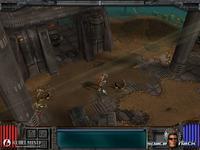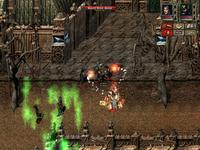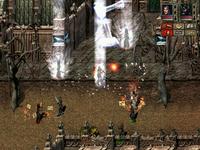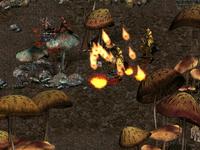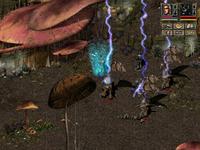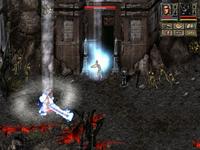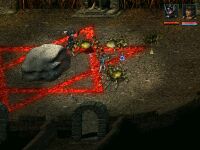| |
Site Navigation
Main
News
Forums
Games
Games Database
Top 100
Release List
Support Files
Features
Reviews
Previews
Interviews
Editorials
Diaries
Misc
Download
Gallery
Music
Screenshots
Videos
Miscellaneous
Staff Members
Privacy Statement
|
|
Beyond Divinity Review
Brian 'Dhruin' Turner, 2004-05-10 
Divine Divinity impressed many players in 2002 with its unique combination of action, non-linearity and story-driven questing - all wrapped up with a deep level of world interaction and Larian's quirky take on traditional high fantasy. Beyond Divinity shares many traits with Divine Divinity but isn't a direct sequel, instead offering a different view of the Divinity universe.
The story opens via cut-scene storyboards with the main
character a heroic paladin in the service of the Divine hunting down members of the Black Ring. During a battle with a Necromancer, a demon overlord named Samuel is summoned who destroys the Divine forces but drags the paladin back to a dimension known as Nemesis to imprison and torture. While the paladin is lying unconscious in the dungeon, a Death Knight in the service of Samuel arouses his displeasure and the demon devises a sadistic punishment: binding the evil Death Knight to the virtuous paladin in a curse known as soul-forging. The two are bound together and the death of one will kill the other - clearly the two must work together to escape and undo the curse.
Character Creation
Beyond Divinity starts with character creation and the design of two characters - the Hero and the Death Knight. The Hero's appearance can be customised as male or female and a (small) selection of faces, hairstyles and hair colour, although in practice the isometric view doesn't make this very important. The Death Knight's appearance is set. The six primary attributes (Strength, Intelligence, Constitution, Agility, Speed, Survival) can be customised for both characters or selected from a template and finally the starting skill path is selected from Warrior, Mage or Survivor.
Beyond Divinity uses a new open-ended skill system that allows the character to develop in absolutely any way, so the choice at character creation only affects the skills available at the start. New skills must be purchased from trainers or learned from books but there are no class limitations at all - once a skill has been unlocked through a trainer or book, skill points obtained from levelling can be spent to develop that skill. Most players will immediately create complimentary characters - perhaps making the Hero a melee specialist and the Death Knight a magic caster to create a rounded duo.
After creating the two characters, players face the onerous task of escaping Samuel's Citadel. The gameplay in Beyond Divinity will be at once familiar but foreign to Divine Divinity players. While the isometric view, graphics and basic gameplay are similar in many ways, the introduction of the Death Knight and the new skill system makes for a substantially different experience.
Game World
Whereas Divine Divinity was set in a fairly standard fantasy world, most of Beyond Divinity takes place in another dimension and Larian has created some unusual otherworldly settings and inhabitants. Beyond Divinity takes place across four Acts and each Act is completely different, both in setting and form. Many players will miss the large open world of Rivellon - I can certainly remember leaving Aleroth to be staggered by the apparent size of the gameworld. There are plenty of large maps in Beyond Divinity but because they are divided into separate Acts and locations you won't feel the same amazement - but don't let that disappoint you.
Instead, Beyond Divinity is refreshingly different; gone are the green pastures and forests of traditional fantasy, replaced by dark demonic vistas of twisted rock and lava and strange landscapes of giant mushrooms and crystals. Likewise, you won't meet elves and dwarves but demons, imps, dark priests and a strange new race. Overall, this creates a different and much darker atmosphere that I thoroughly enjoyed. While there are no direct similarities, I was reminded at times of Planescape: Torment.
Each Act also has distinctly different gameplay. After the first Act (which is a very linear dungeon crawl), Beyond Divinity opens up quite a bit, although intrinsically Beyond Divinity is fairly linear. While this will no doubt be criticised, I felt most of the Acts offered reasonable freedom while allowing Larian to experiment with some different styles of play as the story progresses.
Gameplay
At its heart, Beyond Divinity is a real-time action-RPG, with fast paced combat, lots of loot and frequent levelling. The addition of the Death Knight (and summoning dolls which we'll get to a little later) changes the action dynamic quite a bit from the usual experience this genre offers. In general, you'll face fewer monsters but the battles tend to be a little tougher. You have direct control over both characters and you can individually manage them or set the behaviour to "Aggressive" so the AI takes over (to a limited degree) while you control only one.
Switching between the characters and using the pause to cope with the tougher battles is really the antithesis of the normal flow of action combat, so Larian has instituted different Play Modes ranging from Easy to Hardcore, which simply equate to different difficulty levels. At the Easy or Action end of the scale players will find enemies much easier, requiring less management and making the game more action oriented. On the Tactical or Hardcore setting the tougher battles require frequent pausing to manage skills, potions and so on. It's a significant oversight that you can't change the mode once the game has started, so players will have to think about the style that suits them or face restarting the game to try a different mode.
I experimented with the different modes early on but eventually played
through on Tactical. The early parts of the first dungeon were very difficult, with essentially no skills and few potions to be able to influence the outcome but this eased as the game developed. I'm not really a fan of real-time action combat but the extra difficulty made it quite enjoyable, despite the interruptions to the flow caused by pausing and party management. Those who enjoy fast-paced combat should think carefully about playing on "Action".
As you win experience, you'll gain attribute points and a skill point each level so you can improve the abilities of your characters to face the challenges ahead. As mentioned, Beyond Divinity uses an open system that allows you develop your characters in any direction once you've learned the skill set from a trainer or book. One of the intriguing ideas that stems from this system is the ability to create your own abilities and spells any way you like.
The interface for this is a tree structure: for example, you may "create" a spell by selecting Wizard --> Elemental Attack --> Focussed --> Missile --> Fire to create a small thrown fireball. There are a huge number of possibilities that allow for some diverse character development. In practice, however, while it's possible to make new combinations there's a good chance you'll simply think of it as a fireball.
With only one skill point per level (plus an additional point every fifth level) and a wide array of some 300 possible skill combinations, Beyond Divinity departs from Divine Divinity substantially in that the characters you develop will have a much narrower skill focus - you won't develop uber-characters that have nearly every ability possible by the end of the game. This requires some careful thought and character planning although you can unlearn skills for a gold penalty. I appreciated having to think a little harder about the role each of my characters would play but there are some cracks in this system.
With the limited number of skill points on offer, it's important the skills are balanced and useful. First, the Warrior skills are broken up by damage (such as slashing, piercing, crushing and so on) rather than weapon type. This in itself isn't a problem - sword-wielding characters will obviously want to develop "Slashing" damage, for example. However it seems unrealistic that a warrior who is handy with a sword doesn't have any proficiency with a magical sword that happens to inflict Shadow damage. This odd decision becomes absurd for archers with specific skills for each of 11 different arrow types - from Fire Arrows to Explosive Arrows.
In addition, some skills are worthless or broken. Embellish adds a few percent of value to items sold to merchants, which is pointless with the huge swag of loot you'll gather. Pick locks is almost essential in Divine Divinity but just doesn't work in Beyond Divinity - I couldn't open anything despite experimenting by pouring in a dozen points. Warriors lack active combat skills, so you won't be performing varied combo attacks. On the whole I applaud the decision to create more focussed characters but aspects of the skill system need work. Players who like to create powerhouse characters will be disappointed but these limitations create some meaning in the "roleplaying".
Like Divine Divinity, one of the strengths of Beyond Divinity is the richness of the elements other than combat. Beyond Divinity has a huge number of quests and while many of them boil down to finding an item or killing an NPC, they're often multi-part or story related, making them more interesting. You'll help cure an Imp village of a mysterious illness, work your way up the ranks of a dark religious order and restore an elder from an ancient race to life. I would have liked to see multiple solutions to more quests and the inclusion of a speech or diplomacy skill.
There are a large number of NPCs to interact with and Beyond Divinity has a robust dialogue system using standard dialogue trees. Although there are many interesting NPCs, they aren't as compelling as some favourites from Divine Divinity like Mardaneus and Zandalor. One thing that has returned from Divine Divinity is the humour and this is something that Larian has obviously worked hard on. There are many genuinely funny moments; suffice to say there's another great moment involving skeletons. A few pop-culture references have crept in such as some nods to Star Trek and The Hitchhikers Guide to the Galaxy. Thankfully, these aren't overpowering and don't spoil the atmosphere too much.
One of the most stunning features of Divine Divinity is the level and scale of interaction with the environment and Beyond Divinity (mostly) keeps this in place. There's a staggering array of items to interact with - virtually every item, be it a cup, saucer, book or gardening rake can be moved or utilised. Equipment degrades and must be repaired and socketed items can be improved with the addition of charms. Characters can make potions through Alchemy and this has been expanded from Divine Divinity with more plants to use but the method has been simplified and isn't as realistic as it used to be. I missed picking mushrooms, making poison and manually applying to my weapons; the new Alchemy system is menu-driven which makes it easy but it lacks the same charm.
Another area of interaction is puzzles. Beyond Divinity features a large number of puzzles to progress past an area or solve a quest that range from finding a lever to games of chess. Many of them are quite devious but in general I didn't find them too frustrating and welcomed the challenge.
Two completely new features are the Battlefields and Summoning Dolls. The
Battlefields are alternative universes the player can teleport to once unlocked, complete with merchants and multilevel dungeons. There is a different Battlefield for each Act with randomly generated quests and dungeon layout. In theory the random nature of the Battlefields provides replayability and an opportunity to escape the game world for some trading or to level up before going back to tackle the "real world". In practice I found them dull and buggy. The quests are obviously generic, followed by a hack and slash journey through repetitive dungeons and made worse by incorrect journal entries and missing monsters. Fortunately, they're completely optional and after playing through the first I didn't return, apart from the convenience of some quick trading.
Summoning Dolls are magical artefacts that summon a creature that joins the party temporarily. The Summoning Dolls can be given weapons and equipment and can be improved by spending skill points in Summoning. They have a limited range and summoning time and given the limited number of skill points available I preferred to spend them elsewhere.
Binding all of these elements together is the story. The real story doesn't make an appearance until a fair way through Act 2, which accounts for some of the tedium in Act 1. Once you become involved, it's an entertaining tale although you won't fully appreciate it until the end. One of the best aspects is that the Hero isn't the saviour of the universe - for once.
Interface
Beyond Divinity's interface is a mixed bag. The main screen layout is quite clean and maximises the viewable area. In the top tight-hand corner are character portraits with Vitality, Mana and Stamina bars and buttons to access the usual items like the diary and inventory as well as select active skills and drink potions. An optional minimap defaults to the top left-hand corner but can be moved if desired.
Inventory, character statistics and equipment paper-doll have all been integrated into one screen. At first this appears an efficient move but occasionally items need to be dragged into the inventory and the huge size of this interface obscures most of the screen. Worst of all, the inventory is an absolute mess. There's no grid or ability to sort items neatly and items can pile up on each other hiding smaller objects. There are small filter buttons that hide the specified category but it's not adequate. The automap is well detailed and key locations are annotated, although the descriptions are often inadequate. Thankfully, you can add your own notes, which is welcome. The Quest Diary is adequate although I missed the time stamp from Divine Divinity and the Trophies screen is useful to examine the resistances and weaknesses of monsters that have been killed.
I really would have liked a formation system. Beyond Divinity tries to move both the Hero and Death Knight aligned vertically and depending on the path it can be a pain controlling which character arrives first: vital when one character is a front-line melee specialist and the other a weaker ranged or magic user.
Graphics and Sound
Beyond Divinity uses an enhanced version of the Divine Divinity engine. The highly detailed 2D backgrounds remain but the characters and spell effects have been completely overhauled with 3D replacements and the engine supports resolutions up to 1600x1200. The background art is beautiful and full of the tiniest details even though it may not be the latest technology. Larian has a slightly peculiar artistic style that won't be appreciated by everyone but adds a unique flavour for me.
The new 3D characters aren't appreciably better than their old 2D counterparts although there are an impressive variety of new monsters that look quite good. There's a fairly limited number of animations so unlike some action-RPGs, you won't be entertained by impressive combat manoeuvres. There are also some minor animation glitches such as some skating in the character movement.
Beyond Divinity takes the player to some fantastical environments and these have been nicely realised with original and varied locales, although dungeon areas can be repetitive. Spell effects are colourful and spectacular. Despite the attractive art, the backgrounds are largely static and there are no flowing robes or other touches that modern engines sport. The new 3D additions allow the view to be zoomed but I didn't find this particularly useful.
Dialogue in Beyond Divinity is entirely voiced (except for the Battlefields). As a constant companion who makes sarcastic observations and comments, the Death Knight's gruff voice can grate and emphasis is often placed on the wrong words. Fortunately, it seems to improve as the game progresses, perhaps as the actor becomes relaxes with the role. The other voices vary from average to excellent. In particular, some of the voices are outrageously camp but when coupled with the often-comedic lines it works.
Kirill Pokrovsky reprises his role from Divine Divinity as the composer for
Beyond Divinity. While the new title music isn't as impressive as Divine Divinity, many of the other tracks throughout the game are spectacular, with haunting melodies and soaring choral voices. I found the music compelling and would have played on just to hear the music in entirety. Sound effects are solid and functional.
Summary
One of the frustrating aspects of Beyond Divinity is the lack of polish. There are numerable small annoyances from minor text editing errors to in-game cut-scenes that cut in before you can see the trigger. The initial game release had a number of small bugs but Larian has been active releasing patches to address many of these issues and no doubt will continue to do so.
Despite the lack of polish and some of the new ideas falling a little flat, Beyond Divinity succeeds overall because the basic gameplay works, coupled with a strong story and great interaction with the gameworld. The biggest hurdle to players enjoying Beyond Divinity is their expectation for Beyond Divinity to be Divine Divinity 2 and the tedious opening dungeon.
Larian has bravely decided to experiment with the Divinity formula and offer a new experience in an original setting. While some of the changes don't succeed, Beyond Divinity offers fun and addictive gameplay with more depth than virtually any other RPG since Divine Divinity.
|
The Verdict
|
Graphics (15%) |
79% |
|
|
Sound (15%) |
83% |
|
Control (25%) |
77% |
|
Fun (45%) |
81% |
|
Overall
|
80%
|
|
The ups and downs:
| Interesting setting | More linear than Divinity | | Skill system | Skill system | | Interactivity | Lacks polish | | Good story | |
|
Reviewer's System
|
Version: |
1.32 |
|
CPU: |
P4 2.8Ghz |
|
RAM: |
1024Mb |
|
Graphics |
Radeon 9700 Pro |
|
Sound |
SB Live |
|
OS: |
Win XP Pro |
|
Average Reader Ratings: 6.68 (19 votes) Rate this title and view comments Game Info Printer Friendly Version |
|




